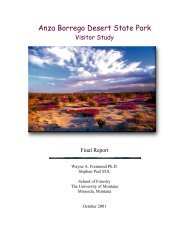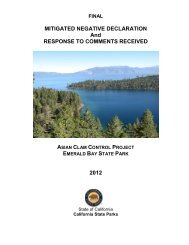Draft EIS/EIR for the San Luis Reservoir SRA Resource ...
Draft EIS/EIR for the San Luis Reservoir SRA Resource ...
Draft EIS/EIR for the San Luis Reservoir SRA Resource ...
You also want an ePaper? Increase the reach of your titles
YUMPU automatically turns print PDFs into web optimized ePapers that Google loves.
Appendix B. Biological Survey Forms and Project Area Vegetation<br />
varies between 25 and 50 percent and <strong>the</strong> height of <strong>the</strong> vegetation is generally less than 3 feet.<br />
The understory of <strong>the</strong> Cali<strong>for</strong>nia sagebrush scrub mainly consists of grassland growing between<br />
<strong>the</strong> shrubs. The area beneath <strong>the</strong> shrubs is bare.<br />
Mesic Herbaceous<br />
Mesic herbaceous vegetation occurs in seeps, within watercourses, and at <strong>the</strong> edges of <strong>the</strong><br />
reservoirs. It consists of species adapted to seasonally, as well as permanently, wet conditions.<br />
This mesic herbaceous vegetation consists of tall vegetation such as cattails and tules to short<br />
vegetation such as crabgrass and knotgrass (Paspalum distichum). The cattails (Typha latifolia<br />
and unidentified species) and tules (Scirpus acutus spp. occidentalis) grow in extensive patches<br />
along <strong>the</strong> edges of <strong>the</strong> reservoirs within standing water. These stands can be small patches 10 by<br />
20 feet in size to several hundred feet long and 30 feet wide. Often water parsley (Oenan<strong>the</strong><br />
sarmentosa) and water smartweed (Polygonum pundatum) occur with <strong>the</strong> cattails and tules.<br />
Mexican rush Juncus mexicanus) commonly occurs at <strong>the</strong> edges of <strong>the</strong> reservoirs above <strong>the</strong><br />
reservoir's edge. The iris-leaved rush (Juncus xiphioides) also occurs in watercourses, and seeps.<br />
The rushes often grow as dense mats of single species stands. Meadow barley (Hordeum<br />
brachyan<strong>the</strong>rum) and creeping wildrye (Leymus triticoides) are adapted to drier conditions than<br />
<strong>the</strong> iris-leaved rush and grow at <strong>the</strong> edge of seeps and o<strong>the</strong>r wet areas.<br />
Cocklebur often grows in dense aggregations at <strong>the</strong> areas where watercourses flow into stock<br />
ponds, and spiny clot-bur (Xantium spinosum) occurs in low-density aggregations within<br />
drawdown and disturbed areas.<br />
Seeps and watercourses often support water cress (Rorippa nasturtium-aquaticum) growing in<br />
areas of ponded water. Rabbit's foot grass (Polypogon monspeliense) and curly dock (Rumex<br />
crispus) also grow in wet areas onsite.<br />
Grassland<br />
The grassland vegetation type occurs extensively throughout <strong>the</strong> areas surrounding <strong>San</strong> <strong>Luis</strong> and<br />
Los Banos reservoirs and O'Neill Forebay. This grassland varies in height from a few inches and<br />
25 to 50 percent cover in sites with shallow soils, to 1.5 feet and I00 percent cover in <strong>the</strong> sites<br />
with deeper soils.<br />
Different species dominate <strong>the</strong> grassland in different areas. The occurrence of a particular species<br />
as a dominant may be <strong>the</strong> result of particular edaphic, climatic, and moisture conditions. Most of<br />
<strong>the</strong> dominants are non-native species but purple needlegrass (Nasella pulehra), a native species,<br />
occurs throughout <strong>the</strong> park in various densities. It occasionally grows as a dominant on <strong>the</strong> slopes<br />
of <strong>San</strong> <strong>Luis</strong> and Los Banos reservoirs. The o<strong>the</strong>r dominants include ripgut brome, hare barley<br />
(Hordeum murinum ssp. leporinum), wild oats (Avena sp.), and Italian ryegrass (Loltum<br />
multif!orum), Various species of tarweeds also occur in various densities ranging from low to<br />
high in <strong>the</strong> grassland. They also occur as dominant or subdominant species of small areas. The<br />
species of tarweeds are Fitch's spikeweed, common spikeweed (Hemizonia pungens), and <strong>San</strong><br />
Joaquin tarweed (Holoearpha obeoniea). Big tarweed (Blepharizonia plumosa ssp, viscida)<br />
occasionally occurs in <strong>the</strong> grassland and vinegar weed (Trichostemma lanceo/atum) often occurs<br />
as a subdominant in <strong>the</strong> grassland.<br />
Some portions of <strong>the</strong> grassland are dominated by native species of grass. Often <strong>the</strong>se native areas<br />
are correlated with sloping areas and shallow soil. Natives such as pine bluegrass often grow<br />
beside <strong>the</strong> Cali<strong>for</strong>nia sagebrush scrub on <strong>the</strong> slopes of Los Banos <strong>Reservoir</strong>. Creeping wildrye, a<br />
native species, can dominate moist areas.<br />
B-6 <strong>San</strong> <strong>Luis</strong> <strong>Reservoir</strong> <strong>SRA</strong><br />
<strong>Draft</strong> RMP/GP and <strong>Draft</strong> <strong>EIS</strong>/<strong>EIR</strong>
















